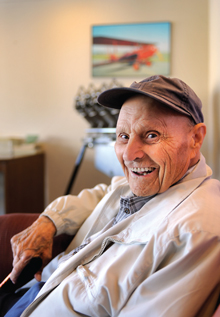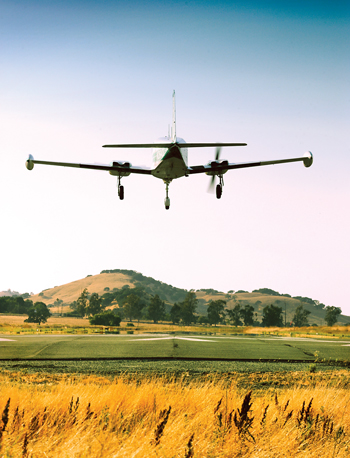The low, pale green buildings make it hard to spot from Highway 101. The tall, cluttered sign at the Atherton off-ramp north of Novato doesn’t help matters, and the following mile of bumpy, patched-up two-lane asphalt screams, “This can’t possibly be the way.” But keep going and you’ll arrive at Marin County Airport, mostly known now as Gnoss (“guh-noss”) Field.
More than 200 private pilots call the county-owned general aviation facility home. “We’re a colorful and compatible group of people,” says Mark Sheron, president of the Gnoss Field Community Association, a recently formed group he says is “hoping to call attention to Gnoss Field and the things that happen out here.”
The daring but mostly not-so-young men (and a few women) who berth their flying machines in Gnoss Field’s hangars are a contented group. All fly for pleasure, but several also take to the air regularly for work.
Chuck Jessen, for example, a Mill Valley filmmaker and director, says he flies himself “to L.A. about once a month. At 200 miles an hour, it takes just under two hours; I love it.” Though taking his own twin-engine 1955 Cessna 310 plane, which has more than 4,300 hours of flight time, costs more than flying commercial, the 6-foot-3 Jessen is happy to avoid the cramped seats, crowded airports and delay-and-cancellation drama of major airline flights.
Kirk Heiser, president of the San Rafael architecture firm Heiser and Associates, regularly flies himself to his many projects. “For 30 years, I’ve flown up and down California,” he says. “The other day, a problem came up regarding a school in Kern County; I got there almost immediately.” In recent months Heiser’s business has had him landing at airports in Torrance, Truckee, San Luis Obispo and Eureka—places not frequented by the airlines: “I can visit two or three job sites in a day.” He pilots an efficient 1982 Beechcraft Bonanza previously owned by a Microsoft exec.
Novato attorney Lou Franecke has a job that might seem at odds with being a pilot. “As an aviation attorney,” he says, “I fly throughout the West investigating airplane crashes.” Franecke’s recent cases have taken him to Fresno, Santa Barbara and Grants Pass, Oregon. “It’s so much faster in your own aircraft than flying Southwest out of Oakland.” Franecke—who growing up wanted to be an astronaut and solo-piloted when he was just 16—can be pre-flighting (safety inspecting) his Beechcraft Bonanza 10 minutes after leaving his house.
Gnoss Field is celebrating its 50th year of operation—more or less. Actually, it was in 1946 that two former World War II pilots carved a dirt airstrip out of a cow pasture in the same general location as the current field. According to old-timer Woody Binford, “a couple of old Aeronca Champs, an open-cockpit Stearman biplane and a Stinson high-winged job dominated the scene.”
Seasonal flooding from nearby Black John Slough was a problem, though, so in 1959 the county got involved. Within a decade, a Federal Aviation Administration study was completed, an additional 40 acres were purchased, and the runway was relocated a quarter mile east, reoriented to its present northwest-southeast alignment and paved.
 The field’s name is a tribute to William Gnoss, a 1960s Marin County supervisor who led the effort to fund the enterprise and presided over its official opening on October 25, 1968. In 1995, the 3,300-foot-long runway was widened to 75 feet. An 1,100-foot extension is now under study. “It’s not imminent,” airport manager Ken Robbins says. “We’re looking at completion near the end of 2011.”
The field’s name is a tribute to William Gnoss, a 1960s Marin County supervisor who led the effort to fund the enterprise and presided over its official opening on October 25, 1968. In 1995, the 3,300-foot-long runway was widened to 75 feet. An 1,100-foot extension is now under study. “It’s not imminent,” airport manager Ken Robbins says. “We’re looking at completion near the end of 2011.”
Gnoss Field, which operates under the purview of the county Depart- ment of Public Works, has fuel and service facilities for prop and jet aircraft, but it has no commercial air operations and no control tower. Pilots determine on their own when, where and how to take off and land.
Adding to that challenge, the field is famous for treacherous crosswinds affecting the many take-offs heading into the northwest. “It can be tricky,” says Jessen. “Wind socks on opposite ends of the runway are often blowing in different directions, but over time we get used to it.”
Further, pilots are instructed to stay away from the high-end homes in the hills along Atherton Avenue near the south end of the field: “We have very specific noise-abatement procedures that specify tight approach and departure patterns,” Jessen says. “We like to be on good terms with our neighbors.”
Flying is an expensive pastime. The training needed for a pilot’s license can cost “up to $10,000,” says Dave Ward, owner of AirWard, a flying school and plane rental service based at Gnoss. The purchase price for even a well-used plane can run from $30,000 to over $100,000 (and much, much more for new, high-tech models). Net costs per flight hour including fuel can be $125 an hour and up. Then there’s the required annual airframe and power plant inspection (at least $2,500,” says Franecke) and next comes hangar rent. The tariff for one of Gnoss’s 195 steel units averages $300 a month.
Each of these hangars has “a different story to tell,” says Matt Mitchell, a Larkspur/Corte Madera motorcycle cop and a pilot for the past two years. “It’s like a museum out here—two pilots are building their own plane, one’s restoring a Merlin Mustang from the 1930s and another hangar has a brand-new Citation jet sitting inside.”
Mitchell’s own hangar resembles something out of a ’40s Gary Cooper movie, one involving barnstormers and air shows. It holds Mitchell’s seven-seat 1965 Piper Cherokee (nicknamed “Big Eddie”), his motorcycle, a Doodle Bug motor scooter, two bikes, a microwave oven, fridge, boom box, and an overstuffed armchair that faces a tiny dust-covered TV. “Can you tell it’s my home away from home?” he asks.Mitchell uses his plane strictly for recreation. “A favorite flight for my wife, Debbie, and me,” he says, “is to take off, head straight south for John Wayne Airport and Newport Beach, meet some buddies; then we’ll fly ‘squadron-style’ over to Catalina Island.”
A friend of Mitchell’s, 24-year-old aviation mechanics student Rob Anderson, prefers the opposite direction. In his four-seat Piper Cherokee, “my favorite destination is Shelter Cove, a fishing village about an hour north between Fort Bragg and Eureka. Their little landing strip juts out to sea, so it’s a little like landing on an aircraft carrier.”
Both the county sheriff’s department and the California Highway Patrol keep planes at Gnoss, and the field is sometimes used by the Coast Guard, the state Department of Forestry, and the U.S. Air Force’s Civil Air Patrol. Numerous humanitarian flights also originate here, says Gnoss Field Community Organization’s Sheron.
For example, Jeff Clarke, CEO of San Francisco–based KQED, is active with several other Gnoss pilots in Angel Flights, a nationwide group providing free air transportation to meet charitable or medical needs. One recent mission involved a Stanford Medical Center kidney patient. Clarke and another pilot “picked her up in San Jose and flew her home to Red Bluff,” he says. “It turned (what would have been) a tough four-hour drive into a scenic flight of just over an hour. We enjoyed helping out.”
The Living Legend
“He comes in most mornings,” says airport manager Ken Robbins, “he gets his cup of coffee, walks into the pilots’ lounge and talks with whoever’s there.” That’s Henry Beadle, age 96, Gnoss Field’s living legend.
 “Being mechanically inclined, I was drawn to airplanes back in ’29,” he might say at first meeting. “I pretty much taught myself to fly.” The conversation could then focus on the Waco 10 biplane flown in the late ’30s and that it had a Curtis OXX-6 engine similar to the one displayed adjacent to where Beadle is sitting. “Only that has two magnetos,” he points out. “Mine only had one.” Then he softly laughs and his eyes sparkle.
“Being mechanically inclined, I was drawn to airplanes back in ’29,” he might say at first meeting. “I pretty much taught myself to fly.” The conversation could then focus on the Waco 10 biplane flown in the late ’30s and that it had a Curtis OXX-6 engine similar to the one displayed adjacent to where Beadle is sitting. “Only that has two magnetos,” he points out. “Mine only had one.” Then he softly laughs and his eyes sparkle.
Beadle’s glory days came during World War II, when the then-28-year-old volunteered with the Army Air Corps. He taught pilots how to fly a Waco CG-43 glider, the kind that was filled with troops, jeeps and guns then towed in pairs behind enemy lines by a lumbering C-47. Beadle flew both the glider and the C-47 and developed a method with which the plane, while airborne, could snatch a glider off the ground.
“Instructing was a good job,” is about all he’ll say about his wartime service. Beadle was discharged at Novato’s Hamilton Air Force Base in 1960 and has lived in Marin ever since. “For a few years, I flew recreationally with the Aero Club at Hamilton,” Beadle recalls, “then I sold my Stinson and in 1973 built a Mustang II—it was powered by a Lycoming 0-320 and cruised along at 170 miles per hour.”
There’s a display case in the pilots’ lounge at Gnoss Field holding Henry Beadle’s old flight logs, his army cap and photos of the planes he’s flown in the past. And if you’re lucky, Henry will be sitting nearby—coffee in hand, waiting to talk.


